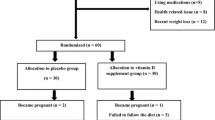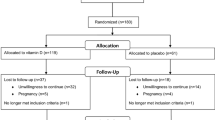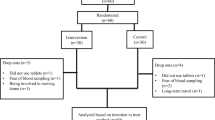Abstract
Background: Women with polycystic ovary syndrome (PCOS) frequently suffer from metabolic disturbances, in particular from insulin resistance. Accumulating evidence suggests that vitamin D deficiency may contribute to the development of insulin resistance. Hence, we aimed to examine the effect of vitamin D supplementation on metabolic and endocrine parameters in PCOS women. Methods: Fifty-seven PCOS women were included in the study. PCOS women received 20,000 IU cholecalciferol weekly for 24 weeks. Anthropometric measures, oral glucose tolerance test, and blood analyses of endocrine parameters were performed at baseline and after 12 weeks (V2) and 24 weeks (V3). Results: Forty-six PCOS women finished the study. 25-hydroxyvitamin D [25(OH)D] levels significantly increased from 28.0±11.0 ng/ml at baseline to 51.3±17.3 and 52.4±21.5 at V2 and V3, respectively (p<0.001). We observed a significant decrease of fasting and stimulated glucose (V3, p<0.05) and C-peptide levels (V2 and 3, p<0.001) after vitamin D treatment. Moreover, triglyceride and estradiol levels significantly decreased at V3 (p=0.001) and V2 (p=0.022), respectively, whereas total cholesterol (V2, p=0.008) and LDL cholesterol levels (V2, p=0.005; V3, p=0.026) significantly increased after vitamin D treatment. There were no changes in androgens. At V2, 14 out of 46 PCOS women previously affected by menstrual disturbances (30.4%) reported improvement of menstrual frequency; at V3, 23 out of 46 women (50.0%), who were oligo- or amenorrheic at baseline reported improvement. Discussion: Our results suggest that vitamin D treatment might improve glucose metabolism and menstrual frequency in PCOS women. Further randomized controlled trails are warranted to confirm our findings.
Similar content being viewed by others
References
Asunción M, Calvo RM, San Millán JL, Sancho J, Avila S, Escobar-Morreale HF. A prospective study of the prevalence of the polycystic ovary syndrome in unselected Caucasian women from Spain. J Clin Endocrinol Metab 2000, 85: 2434–8.
Diamanti-Kandarakis E, Kouli CR, Bergiele AT, et al. A survey of the polycystic ovary syndrome in the Greek island of Lesbos: hormonal and metabolic profile. J Clin Endocrinol Metab 1999, 84: 4006–11.
Dunaif A. Insulin resistance and the polycystic ovary syndrome: mechanism and implications for pathogenesis. Endocr Rev 1997, 18: 774–800.
Wehr E, Möller R, Horejsi R, et al. Subcutaneous adipose tissue topography and metabolic disturbances in polycystic ovary syndrome. Wien Klin Wochenschr 2009, 121: 262–9.
Ehrmann DA. Polycystic ovary syndrome. N Engl J Med 2005, 352: 1223–36.
Hahn S, Haselhorst U, Tan S, et al. Low serum 25-hydroxyvitamin D concentrations are associated with insulin resistance and obesity in women with polycystic ovary syndrome. Exp Clin Endocrinol Diabetes 2006, 114: 577–83.
Wehr E, Pilz S, Schweighofer N, et al. Association of hypovitaminosis D with metabolic disturbances in polycystic ovary syndrome. Eur J Endocrinol 2009, 161: 575–82.
Holick MF. Vitamin D deficiency. N Engl J Med 2007, 357: 266–81.
Pittas AG, Lau J, Hu FB, Dawson-Hughes B. The role of vitamin D and calcium in type 2 diabetes. A systematic review and meta-analysis. J Clin Endocrinol Metab 2007, 92: 2017–29.
Freundlich M, Quiroz Y, Zhang Z, et al. Suppression of renin-angiotensin gene expression in the kidney by paricalcitol. Kidney Int 2008, 74: 1394–402.
Chiu KC, Chu A, Go VL, Saad MF. Hypovitaminosis D is associated with insulin resistance and beta cell dysfunction. Am J Clin Nutr 2004, 79: 820–5.
Isaia G, Giorgino R, Adami S. High prevalence of hypovitaminosis D in female type 2 diabetic population. Diabetes Care 2001, 24: 1496.
Mahmoudi T, Gourabi H, Ashrafi M, Yazdi RS, Ezabadi Z. Calciotropic hormones, insulin resistance, and the polycystic ovary syndrome. Fertil Steril 2010, 93: 1208–14.
Konradsen S, Ag H, Lindberg F, Hexeberg S, Jorde R. Serum 1,25-dihydroxy vitamin D is inversely associated with body mass index. Eur J Nutr 2008, 47: 87–91.
Parikh SJ, Edelman M, Uwaifo GI, et al. The relationship between obesity and serum 1,25-dihydroxy vitamin D concentrations in healthy adults. J Clin Endocrinol Metab 2004, 89: 1196–9.
Heaney RP, Horst RL, Cullen DM, Armas LA. Vitamin D3 distribution and status in the body. J Am Coll Nutr 2009, 28: 252–6.
Rotterdam ESHRE/ASRM-Sponsored PCOS consensus workshop group. Revised 2003 consensus on diagnostic criteria and longterm health risks related to polycystic ovary syndrome (PCOS). Hum Reprod 2004, 19: 41–7.
Legro RS, Castracane VD, Kauffman RP. Detecting insulin resistance in polycystic ovary syndrome: purposes and pitfalls. Obstet Gynecol Surv 2004, 59: 141–54.
Ish-Shalom S, Segal E, Salganik T, Raz B, Bromberg IL, Vieth R. Comparison of daily, weekly, and monthly vitamin D3 in ethanol dosing protocols for two months in elderly hip fracture patients. J Clin Endocrinol Metab 2008, 93: 3450–5.
Whiting SJ, Calvo MS. Correcting poor vitamin D status: do older adults need higher repletion doses of vitamin D3 than younger adults? Mol Nutr Food Res 2010, 54: 1077–84.
Zittermann A, Frisch S, Berthold HK, et al. Vitamin D supplementation enhances the beneficial effects of weight loss on cardiovascular disease risk markers. Am J Clin Nutr 2009, 89: 1321–7.
Pilz S, Dobnig H, Winklhofer-Roob B, et al. Low serum levels of 25hydroxyvitamin D predict fatal cancer in patients referred to coronary angiography. Cancer Epidemiol Biomarkers Prev 2008, 17: 1228–33.
Pilz S, März W, Wellnitz B, et al. Association of vitamin D deficiency with heart failure and sudden cardiac death in a large cross-sectional study of patients referred for coronary angiography. J Clin Endocrinol Metab 2008, 93: 3927–35.
Autier P, Gandini S. Vitamin D supplementation and total mortality: a meta-analysis of randomized controlled trials. Arch Intern Med 2007, 167: 1730–7.
Bischoff-Ferrari HA, Willett WC, Wong JB, et al. Prevention of nonvertebral fractures with oral vitamin D and dose dependency: a meta-analysis of randomized controlled trials. Arch Intern Med 2009, 169: 551–61.
Zittermann A, Gummert JF, Börgermann J. Vitamin D deficiency and mortality. Curr Opin Clin Nutr Metab Care 2009, 12: 634–9.
Pittas AG, Harris SS, Stark PC, Dawson-Hughes B. The effects of calcium and vitamin D supplementation on blood glucose and markers of inflammation in nondiabetic adults. Diabetes Care 2007, 30: 980–6.
Hsia J, Heiss G, Ren H, et al; Women’s Health Initiative Investigators. Calcium/vitamin D supplementation and cardiovascular events. Circulation 2007, 115: 846–54.
Kotsa K, Yavropoulou MP, Anastasiou O, Yovos JG. Role of vitamin D treatment in glucose metabolism in polycystic ovary syndrome. Fertil Steril 2009, 92: 1053–8.
Selimoglu H, Duran C, Kiyici S, et al. The effect of vitamin D replacement therapy on insulin resistance and androgen levels in women with polycystic ovary syndrome. J Endocrinol Invest 2010, 33: 234–8.
Lacour B, Basile C, Drüeke T, Funck-Brentano JL Parathyroid function and lipid metabolism in the rat. Miner Electrolyte Metab 1982, 7: 157–65.
Rajpathak SN, Xue X, Wassertheil-Smoller S, et al. Effect of 5 y of calcium plus vitamin D supplementation on change in circulating lipids: results from the Women’s Health Initiative. Am J Clin Nutr 2010, 91: 894–9.
Ozkan S, Jindal S, Greenseid K, et al. Replete vitamin D stores predict reproductive success following in vitro fertilization. Fertil Steril 2010, 94: 1314–9.
Thys-Jacobs S, Donovan D, Papadopoulos A, Sarrel P, Bilezikian JP. Vitamin D and calcium dysregulation in the polycystic ovarian syndrome. Steroids 1999, 64: 430–5.
Yildizhan R, Kurdoglu M, Adali E, et al. Serum 25-hydroxyvitamin D concentrations in obese and non-obese women with polycystic ovary syndrome. Arch Gynecol Obstet 2009, 280: 559–63.
Knight JA, Wong J, Blackmore KM, Raboud JM, Vieth R. Vitamin D association with estradiol and progesterone in young women. Cancer Causes Control 2010, 21: 479–83.
Knight JA, Lesosky M, Barnett H, Raboud JM, Vieth R. Vitamin D and reduced risk of breast cancer: a population-based case-control study. Cancer Epidemiol Biomarkers Prev 2007, 16: 422–9.
Pike MC, Spicer DV, Dahmoush L, Press MF. Estrogens, progestogens, normal breast cell proliferation, and breast cancer risk. Epidemiol Rev 1993, 15: 17–35.
Du H, Daftary GS, Lalwani SI, Taylor HS. Direct regulation of HOXA10 by 1,25-(OH)2D3 in human myelomonocytic cells and human endometrial stromal cells. Mol Endocrinol 2005, 19: 2222–33.
Halloran BP, DeLuca HF. Effect of vitamin D deficiency on fertility and reproductive capacity in the female rat. J Nutr 1980, 110: 1573–80.
Yoshizawa T, Handa Y, Uematsu Y, et al. Mice lacking the vitamin D receptor exhibit impaired bone formation, uterine hypoplasia and growth retardation after weaning. Nat Genet 1997, 16: 391–6.
Kovacs CS, Woodland ML, Fudge NJ, Friel JK. The vitamin D receptor is not required for fetal mineral homeostasis or for the regulation of placental calcium transfer in mice. Am J Physiol Endocrinol Metab 2005, 289: E133–44.
De Felici M, Dolci S, Siracusa G. An increase of intracellular free Ca2+ is essential for spontaneous meiotic resumption by mouse oocytes. J Exp Zool 1991, 260: 401–5.
Holick MF. Sunlight and vitamin D for bone health and prevention of autoimmune diseases, cancers, and cardiovascular disease. Am J Clin Nutr 2004, 80: 1678–88S.
Author information
Authors and Affiliations
Corresponding author
Rights and permissions
About this article
Cite this article
Wehr, E., Pieber, T.R. & Obermayer-Pietsch, B. Effect of vitamin D3 treatment on glucose metabolism and menstrual frequency in polycystic ovary syndrome women: A pilot study. J Endocrinol Invest 34, 757–763 (2011). https://doi.org/10.3275/7748
Accepted:
Published:
Issue Date:
DOI: https://doi.org/10.3275/7748




